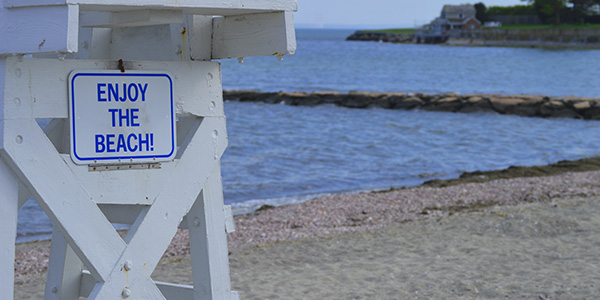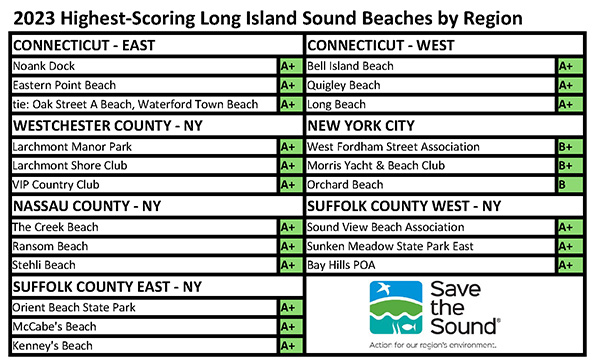
As beachgoers around Long Island Sound prepare for the arrival of Memorial Day Weekend and the start of a new swimming season, Save the Sound releases its 2023 Beach Grades on Sound Health Explorer. Before diving into the Sound this summer, we encourage everyone to dive into the water quality grades collected last summer at 197 public and private beaches.
Seventy-three percent of the beaches received grades in either the A or B range. The top beaches with the highest-scoring water quality grades for each of seven regions around Long Island Sound are listed in the table below.
“The positive news is that there are a ton of great beaches for swimming all the way around Long Island Sound and many received excellent marks with respect to water quality,” said Peter Linderoth, director of water quality for Save the Sound.
The science-driven Beach Grades reflect water quality data collected at each beach by local health departments and uploaded to the Environmental Protection Agency’s Water Quality Portal database. The weekly samples gathered throughout the swimming season measure fecal indicator bacteria levels and are evaluated against state criteria for safe swimming. High counts of fecal indicator bacteria are associated with pathogens in the water that can make people sick. These high counts of bacteria can be associated with untreated sewage or abundant polluted stormwater entering the waters at or near a beach.
Stormwater runoff is particularly problematic where there is significant impervious surface coverage near the beach and in nearby lands that drain to it: parking lots, streets, sidewalks, and rooftops, which rainfall cannot penetrate. Instead, it cascades into catch basins and storm drains, carrying along fertilizer, pesticides, oil and fuel residue, tire debris, and fecal indicator bacteria, which can originate from pet waste not discarded properly or waste from raccoons, rodents, or other wildlife living inside stormwater pipes. Too often, stormwater also picks up spills and leaks from sanitary sewer infrastructure and septic systems, adding human waste to the mix of polluted runoff delivered to our beaches.
The Long Island Sound region received 18 inches of rain from May through August last year. That was up slightly from the average of the previous three seasons (17 inches from 2020 through 2022), but down from the record 23 inches that fell in the region in 2021.
Wet weather leads to beach closures, largely due to the spike of fecal indicator bacteria present under wet conditions. Because of climate change, we can expect storms to continue to intensify over the coming decades and rainfall totals to increase correspondingly.
“Reducing stormwater runoff helps beaches, and improving underground sewer collection infrastructure is going to result in better water quality and, consequently, better grades,” said Linderoth.
Eleven beaches received D grades or lower in 2023, eight of which are in either Westchester County or New York City. In the City, sewer systems are combined to carry both stormwater and wastewater; in rainstorms, the combined volume of water overwhelms those outdated systems, leading to the discharge of untreated wastewater and stormwater into nearby waterways. There is also a higher percentage of impervious surface in the lands draining to the western reaches of Long Island Sound. These circumstances create a challenge for NYC residents looking for safe places to swim that are also open to the public.
“We were encouraged to see Orchard Beach in the Bronx get a B in 2023, after receiving a C in 2022,” said David Abreu, clean water advocacy specialist for Save the Sound. Orchard Beach received grades in the A range every year from 2013 through 2021. “It’s the only public Sound beach in the Bronx. When it’s not doing well, everyone is out of convenient options for swimming in Long Island Sound.”

Save the Sound uses these Beach Grades to provide information to the public and to target areas in need of fecal contamination reduction. We encourage residents to discuss their local grades with their elected officials, health departments, and other municipal personnel. Residents are also welcome to contact Save the Sound with any questions, comments, or leads on where fecal contamination may be stemming from at a given beach.
The next Long Island Sound Beach Report will be issued in the spring of 2025. Be sure to look for the 2024 Long Island Sound Report Card, which measures the ecological health of the open Sound and its bays and harbors, this fall.
